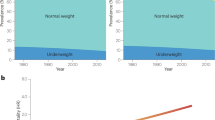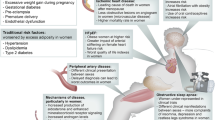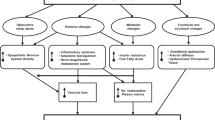Abstract
Obesity is becoming a worldwide phenomenon. Myocardial changes associated with the obese state are increasingly recognized, independent of hypertension, obstructive sleep apnea and coronary artery disease. The existence of a cardiomyopathy of obesity is supported by a range of evidence: epidemiologic study findings, which have shown an association between obesity and heart failure; clinical studies that have confirmed the association of adiposity with left ventricular dysfunction, independent of hypertension, coronary artery disease and other heart disease; and experimental evidence of structural and functional changes in the myocardium in response to increased adiposity. The most important mechanisms in the development of obesity cardiomyopathy are metabolic disturbances (insulin resistance, increased free fatty acid levels, and also increased levels of adipokines), activation of the renin–angiotensin–aldosterone and sympathetic nervous systems, myocardial remodeling, and small-vessel disease (both microangiopathy and endothelial dysfunction). In the first part of this two-part Review, we seek to evaluate the emerging evidence for the existence of a cardiomyopathy of obesity and clarify the responsible mechanisms.
Key Points
-
The existence of a cardiomyopathy of obesity is increasingly recognized and supported by many experimental models and epidemiological and clinical studies
-
These myocardial changes cannot be ascribed to hypertension, diabetes, obstructive sleep apnea or coronary artery disease
-
Obesity cardiomyopathy involves both left and right ventricular structure, and systolic and diastolic function
-
Metabolic factors (insulin resistance, lipotoxicity, increased free fatty acids, and adipokines), renin–angiotensin–aldosterone and sympathetic nervous systems, myocardial remodeling and small vessel disease can all contribute
This is a preview of subscription content, access via your institution
Access options
Subscribe to this journal
Receive 12 print issues and online access
$209.00 per year
only $17.42 per issue
Buy this article
- Purchase on Springer Link
- Instant access to full article PDF
Prices may be subject to local taxes which are calculated during checkout
Similar content being viewed by others
References
Allison DB et al. (1999) Annual deaths attributable to obesity in the United States. JAMA 282: 1530–1538
Duflou J et al. (1995) Sudden death as a result of heart disease in morbid obesity. Am Heart J 130: 306–313
Kasper EK et al. (1992) Cardiomyopathy of obesity: a clinicopathologic evaluation of 43 obese patients with heart failure. Am J Cardiol 70: 921–924
Smith HL and Willius FA (1973) Adiposity of the heart. Arch Intern Med 52: 911–931
Warnes CA and Roberts WC (1984) The heart in massive (more than 300 pounds or 136 kilograms) obesity: analysis of 12 patients studied at necropsy. Am J Cardiol 54: 1087–1091
Hubert HB et al. (1983) Obesity as an independent risk factor for cardiovascular disease: a 26-year follow-up of participants in the Framingham Heart Study. Circulation 67: 968–977
Chen YT et al. (1999) Risk factors for heart failure in the elderly: a prospective community-based study. Am J Med 106: 605–612
Dagenais GR et al. (2005) Prognostic impact of body weight and abdominal obesity in women and men with cardiovascular disease. Am Heart J 149: 54–60
Dwyer EM et al. (2000) Role of hypertension, diabetes, obesity, and race in the development of symptomatic myocardial dysfunction in a predominantly minority population with normal coronary arteries. Am Heart J 139: 297–304
He J et al. (2001) Risk factors for congestive heart failure in US men and women: NHANES I epidemiologic follow-up study. Arch Intern Med 161: 996–1002
Kenchaiah S et al. (2002) Obesity and the risk of heart failure. N Engl J Med 347: 305–313
Murphy NF et al. (2006) Long-term cardiovascular consequences of obesity: 20-year follow-up of more than 15,000 middle-aged men and women (the Renfrew-Paisley study). Eur Heart J 27: 96–106
Fischer M et al. (2001) Prevalence of left ventricular diastolic dysfunction in the general population [abstract]. Circulation 104: I1–108
Karason et al. (1997) Effects of obesity and weight loss on left ventricular mass and relative wall thickness: survey and intervention study. BMJ 315: 912–916
Amad KH et al. (1965) The cardiac pathology of chronic exogenous obesity. Circulation 32: 740–745
Lauer MS et al. (1991) The impact of obesity on left ventricular mass and geometry. The Framingham Heart Study. JAMA 266: 231–236
Nakajima T et al. (1985) Noninvasive study of left ventricular performance in obese patients: influence of duration of obesity. Circulation 71: 481–486
Alaud-din A et al. (1990) Assessment of cardiac function in patients who were morbidly obese. Surgery 108: 809–818
de Simone G et al. (1994) Relation of obesity and gender to left ventricular hypertrophy in normotensive and hypertensive adults. Hypertension 23: 600–606
Wong CY et al. (2006) Association of subclinical right ventricular dysfunction with obesity. J Am Coll Cardiol 47: 611–616
Cittadini A et al. (1999) Cardiovascular abnormalities in transgenic mice with reduced brown fat: an animal model of human obesity. Circulation 100: 2177–2183
Mizushige K et al. (2000) Alteration in left ventricular diastolic filling and accumulation of myocardial collagen at insulin-resistant prediabetic stage of a type II diabetic rat model. Circulation 101: 899–907
Wong CY et al. (2004) Alterations of left ventricular myocardial characteristics associated with obesity. Circulation 110: 3081–3087
de Divitiis O et al. (1981) Obesity and cardiac function. Circulation 64: 477–482
Ku CS et al. (1994) Left ventricular filling in young normotensive obese adults. Am J Cardiol 73: 613–615
Crisostomo LL et al. (1999) Comparison of left ventricular mass and function in obese versus nonobese women <40 years of age. Am J Cardiol 84: 1127–1129
Pascual M et al. (2003) Effects of isolated obesity on systolic and diastolic left ventricular function. Heart 89: 1152–1156
Peterson LR et al. (2004) Alterations in left ventricular structure and function in young healthy obese women: assessment by echocardiography and tissue Doppler imaging. J Am Coll Cardiol 43: 1399–1404
Ferraro S et al. (1996) Left ventricular systolic and diastolic function in severe obesity: a radionuclide study. Cardiology 87: 347–353
Ahmed Q et al. (1997) Cardiopulmonary pathology in patients with sleep apnea/obesity hypoventilation syndrome. Hum Pathol 28: 264–269
Alpert MA (2001) Obesity cardiomyopathy: pathophysiology and evolution of the clinical syndrome. Am J Med Sci 321: 225–236
Marshall JD et al. (2005) New Alstrom syndrome phenotypes based on the evaluation of 182 cases. Arch Intern Med 165: 675–683
Peterson LR et al. (2004) Effect of obesity and insulin resistance on myocardial substrate metabolism and efficiency in young women. Circulation 109: 2191–2196
Katz EB et al. (1995) Cardiac and adipose tissue abnormalities but not diabetes in mice deficient in GLUT4. Nature 377: 151–155
Chiu HC et al. (2001) A novel mouse model of lipotoxic cardiomyopathy. J Clin Invest 107: 813–822
Zhou YT et al. (2000) Lipotoxic heart disease in obese rats: implications for human obesity. Proc Natl Acad Sci USA 97: 1784–1789
Cittadini A et al. (1996) Differential cardiac effects of growth hormone and insulin-like growth factor-1 in the rat: a combined in vivo and in vitro evaluation. Circulation 93: 800–809
Listenberger LL and Schaffer JE (2002) Mechanisms of lipoapoptosis: implications for human heart disease. Trends Cardiovasc Med 12: 134–138
McGavock JM et al. (2006) Adiposity of the heart, revisited. Ann Intern Med 144: 517–524
Nickola MW et al. (2000) Leptin attenuates cardiac contraction in rat ventricular myocytes: role of NO. Hypertension 36: 501–505
Minhas KM et al. (2005) Leptin repletion restores depressed β-adrenergic contractility in ob/ob mice independently of cardiac hypertrophy. J Physiol 565: 463–474
Haynes WG et al. (1997) Sympathetic and cardiorenal actions of leptin. Hypertension 30: 619–623
Shibata R et al. (2004) Adiponectin-mediated modulation of hypertrophic signals in the heart. Nat Med 10: 1384–1389
Maeda N et al. (2001) PPARgamma ligands increase expression and plasma concentrations of adiponectin, an adipose-derived protein. Diabetes 50: 2094–2099
Hotamisligil GS et al. (1993) Adipose expression of tumor necrosis factor-alpha: direct role in obesity-linked insulin resistance. Science 259: 87–91
Xu H et al. (2003) Chronic inflammation in fat plays a crucial role in the development of obesity-related insulin resistance. J Clin Invest 112: 1821–1830
Giacchetti G et al. (2002) Overexpression of the renin–angiotensin system in human visceral adipose tissue in normal and overweight subjects. Am J Hypertens 15: 381–388
Goodfriend et al. (1999) Visceral obesity and insulin resistance are associated with plasma aldosterone levels in women. Obes Res 7: 355–362
Lijnen P and Petrov V (1999) Antagonism of the renin–angiotensin system, hypertrophy and gene expression in cardiac myocytes. Methods Find Exp Clin Pharmacol 21: 363–374
Brilla CG et al. (1993) Anti-aldosterone treatment and the prevention of myocardial fibrosis in primary and secondary hyperaldosteronism. J Mol Cell Cardiol 25: 563–575
Harte A et al. (2005) Insulin-mediated upregulation of the renin angiotensin system in human subcutaneous adipocytes is reduced by rosiglitazone. Circulation 111: 1954–1961
Festa A et al. (2000) Heart rate in relation to insulin sensitivity and insulin secretion in nondiabetic subjects. Diabetes Care 23: 624–628
de Jongh RT et al. (2004) Impaired microvascular function in obesity: implications for obesity-associated microangiopathy, hypertension, and insulin resistance. Circulation 109: 2529–2535
Yudkin JS et al. (2005) “Vasocrine” signalling from perivascular fat: a mechanism linking insulin resistance to vascular disease. Lancet 365: 1817–1820
Sundell J et al. (2002) Obesity affects myocardial vasoreactivity and coronary flow response to insulin. Obes Res 10: 617–624
McCrohon JA et al. (2003) Differentiation of heart failure related to dilated cardiomyopathy and coronary artery disease using gadolinium-enhanced cardiovascular magnetic resonance. Circulation 108: 54–59
Thakur V et al. (2001) Obesity, hypertension, and the heart. Am J Med Sci 321: 242–248
Laaban JP et al. (2002) Left ventricular systolic dysfunction in patients with obstructive sleep apnea syndrome. Chest 122: 1133–1138
Grassi G et al. (2005) Obstructive sleep apnea-dependent and -independent adrenergic activation in obesity. Hypertension 46: 321–325
Alpert MA et al. (1995) Relation of duration of morbid obesity to left ventricular mass, systolic function, and diastolic filling, and effect of weight loss. Am J Cardiol 76: 1194–1197
Licata G et al. (1992) Left ventricular function response to exercise in normotensive obese subjects: influence of degree and duration of obesity. Int J Cardiol 37: 223–230
Acknowledgements
The authors gratefully acknowledge the support of the National Health and Medical Research Council, Canberra, Australia (Centers of Clinical Research Excellence Award and postgraduate research scholarship).
Author information
Authors and Affiliations
Corresponding author
Ethics declarations
Competing interests
C Wong declared he has no competing interests.
TH Marwick receives grant support from GE Healthcare and Philips Medical Systems, but unrelated to this topic.
Rights and permissions
About this article
Cite this article
Wong, C., Marwick, T. Obesity cardiomyopathy: pathogenesis and pathophysiology. Nat Rev Cardiol 4, 436–443 (2007). https://doi.org/10.1038/ncpcardio0943
Received:
Accepted:
Issue Date:
DOI: https://doi.org/10.1038/ncpcardio0943
This article is cited by
-
Exploring the Mechanistic Link Between Obesity and Heart Failure
Current Diabetes Reports (2023)
-
The role of iron metabolism in chronic diseases related to obesity
Molecular Medicine (2022)
-
Alterations in Cardiac Tissue of a Natural Obese Rat Model: Implications for Obesity-Associated Cardiomyopathy
Proceedings of the National Academy of Sciences, India Section B: Biological Sciences (2022)
-
Proteomics study on the effect of silybin on cardiomyopathy in obese mice
Scientific Reports (2021)
-
Bariatric surgery and cardiovascular outcome
The Egyptian Heart Journal (2020)




